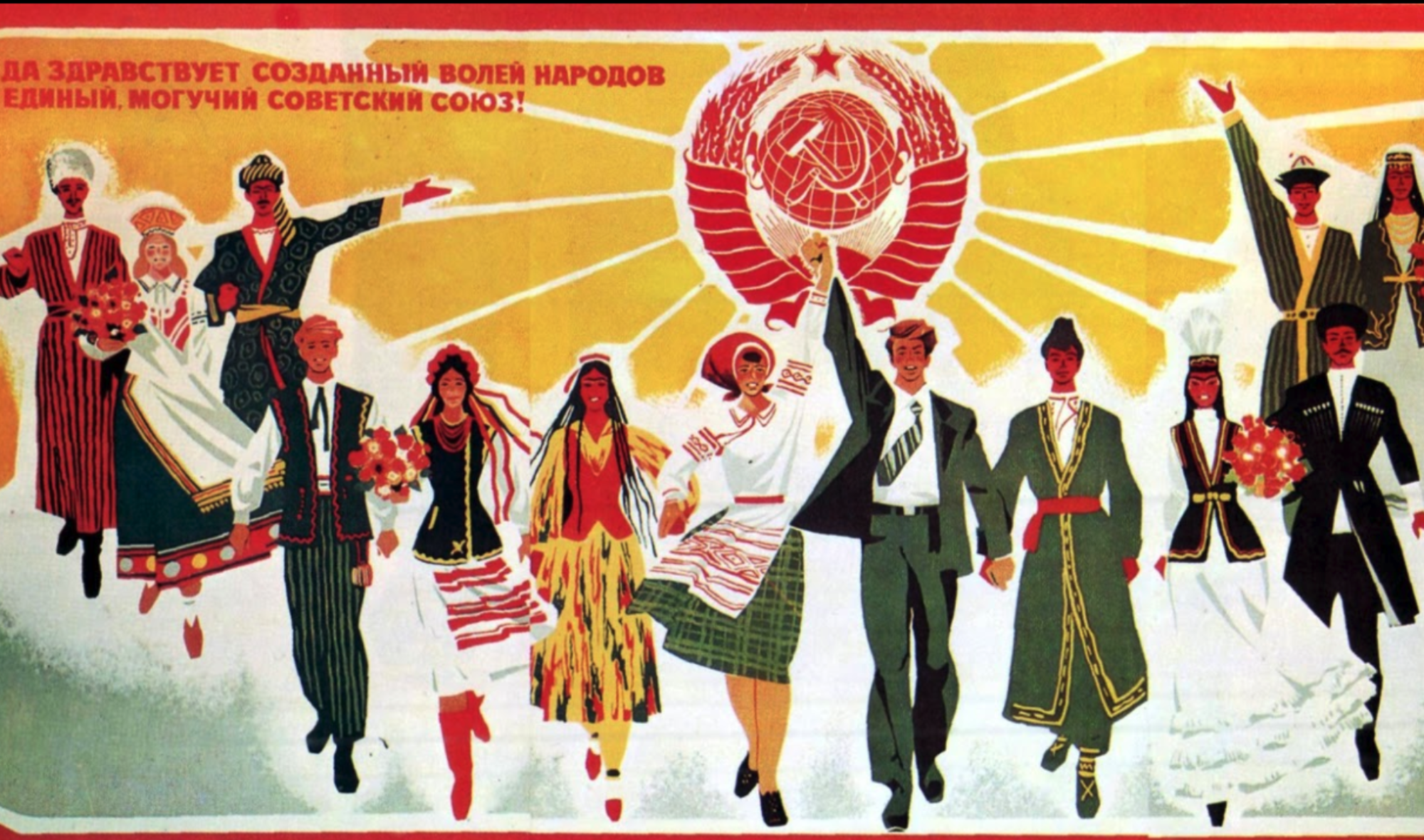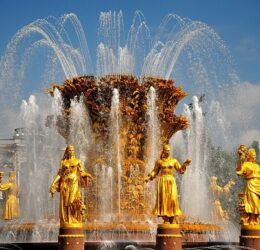In Chapter 6, I found it interesting how Soviet influence and urban planning was rewarded and commemorated in Tashkent. Our discussion last class on Soviet monuments in Uzbekistan (as well as the larger Soviet Union) made me think more about how the Soviets explicitly interjected their culture and icons upon the other nations it governed through monuments and commemoration. Similar in thought, in Chapter 6 I noted the building of the Navoi Opera and Ballet Theater which was regarded as a great success in Soviet Uzbek urban planning (165). This building was magnificently built but allowed the Uzbeks to take great pride in its building because it was more representative of their culture and utilized Uzbek materials (165). It was a source of Uzbek cultural and ethnic pride. However, when commending the building of the theater, the Russian architects garnered the most recognition. The text states, “in analyzing who received the awards, one must recognize that Shchusev, the Russian architect who designed the building and oversaw its construction using Soviet technology, garnered the most praise, while his Uzbek counterparts were seen as craftsmen, skilled in handicrafts but not holding commanding positions as construction engineers or architects. The Soviet pecking order, with Russian technical experts above Uzbek handicraft laborers, is apparent again in the history of this prize-winning building” (168). Overall, I thought it was interesting and incredibly disappointing to almost belittle or view the work of Uzbeks as lesser, especially when the building was built in their country and meant to celebrate their culture. I was wondering the class’s thoughts on this and how it ties to our earlier discussion on Soviet monuments in Uzbekistan.
Modernization in Tashkent
I really enjoyed the chapters on urban planning and the revitalization of Tashkent. Its interesting to read how the Soviet Union launched a campaign to modernize the city to make it a hub for Soviet Central Asia. The text states, “Soviet propaganda hailed Tashkent as the “beacon” of Soviet power in the East that would light the socialist path to prosperity for neighboring peoples of Asia” (40) and “Russian imperial planners sculpted a new European city in the Central Asian desert and hoped that this achievement would entice Muslim Central Asians to join the “modern world.” Those who did not become convinced of European superiority could be left behind in the premodern conditions of Old Tashkent” (44). Both of these quotes encompass the purpose of the modernization plan, however I wonder if it was a worthwhile project for the Soviets to take on and if the early modernization was actually successful.
Display of Imperialism or Celebration of Diversity?
The readings for today touched on the role of music, theater, and opera in the larger Soviet Union regions and how their culture reflected their larger identity and place in Soviet society. I find it interesting how the various nationalities mentioned in the readings went to Moscow to demonstrate their culture and identity and how their music flourished and changed because of this. For example, the text states, “Three hundred Kazak actors, dancers, musicians, poets and writers descended upon Moscow for the festival starting on 17 May 1936. Artists from the Kazak State Musical Theatre and the National Orchestra of the Kazak Philharmonic, as well as popular writers and singers, composed the delegation from Kazakstan” (191). In the reading on Armenian music the author argues, “the level of education was improved, orchestras were established and financially supported, and the arrangement of concerts flourished. However, the effect of Soviet cultural policy on folk music led to a dramatic transformation of not only the music, but of virtually everything to do with this music, from the folk musician’s education and the transmission of songs to the context of performance and the way folk musicians were regarded” (153). It seems like the displays of culture and art was a positive action, however one quote caught my eye from one of the readings. Rouland argued that the Dekada “legitimized Soviet imperial aggression” (190). I thought this was an interesting perspective and was wondering how the class felt.
Traditional Music
I found the music playlist very interesting and it shed light on the different aspects of culture from different regions in the Soviet Union. Each of the videos/songs represented different sounds and utilized different instruments, with some of the instruments being unfamiliar to me. In “Dance of the Kurds and Sabre Dance”, the movements caught my attention the most, but the clashing of instruments and sounds developed an almost foreboding or dark mood. In the second piece, I was really intrigued by the qobyz and the performers traditional clothes. Hearing the difference in the sound and presentation even in music from the same region was interesting to note. I really enjoyed listening and viewing the songs. By listening and watching them, I could understand how music and culture developed in the larger Soviet Union region and how unique each piece was. Overall it put the reading into context and displayed the result of the Soviet Union’s policies attempting to develop music and culture across the various nationalities.
The Role of Art and Soviet Influence
In Chapters 3 and 4, Fowler took a deeper dive into the Soviet government’s control on art and how this focus affected various forms of entertainment. Last class we discussed censorship, but I think it is important to think more about how censorship and manipulation of the arts and media can alter the perception of citizens and how the need to be funded by the state affected the execution of the arts. The text states, “Artists could not depend on book or ticket sales to prove resonance with an audience. Competition among artists for financial support was still fierce, but artists focused not on soliciting interest from the audience members or private patrons, but rather from the Party-state” (Fowler 96) and “With audience input therefore removed, Party-state patronage became crucial to finance theatre, and local connections with officialdom provided the path to securing funds. Socialist theatre had no box office – or at least not a box office contributing in any significant way to a theatre’s income. What mattered for success was not how many tickets a theatre sold, but how many seats its managers succeeded in “organizing” through Party connections” (116). I never thought about just how far the Soviet government financed and influenced art, especially theater, across the various nations.
Questions I’ve been thinking about:
- Do you think catering the message of the arts to benefit the Soviet ideals compromises the purpose of theater, film, literature, etc.?
- On page 113, the author discusses the statistics and number of people who actually visited the Berezil, which turned out to be only about half a percent of the population in Soviet Ukraine, and also states that an even smaller percentage saw Hello from Radiowave 477!. Even with such recorded low audiences in comparison to the overall population, do you think shows and programs like this were influential to developing Soviet Ukrainian art? Were they successful?
- In the last ten pages or so pages of Chapter 3, the author discusses the nationality policy’s affect on the arts, specifically referring to Soviet Ukraine. How did the nationality policy actually hinder minority art and create an ethnic hierarchy?
- Despite the flourishing of art and the representation of various ethnic identities, the founding fathers of art and theater in the Soviet Union all met tragic endings and their legacies were not always discussed positively. The text states, “In 1937 Khvyl’ovyi had committed suicide, Dosvitnyi, Kulish, Iohansen, and Kurbas were shot, and Hirniak and Vyshnia were imprisoned in the gulag” (Fowler 118). Do you think the art movement was still successful in promoting innovation and promoting diverse ethnic identities?
The Experience of the Kazakhs
While the Turksib project was meant to modernize the Soviet Union, it also shed light on the racism the Kazakhs faced. Kazakhs were attacked, beaten, excluded, and discriminated against by Russians and Europeans alike. Payne explains the plight of these people but also emphasizes the efforts of the Soviet government to be inclusive and supportive. To further understand both pieces, I included some questions that I believed were relevant.
Important questions:
- What was the Turksib and why did the plan involve Kazakhs?
- Was the Turksib’s affirmative action plan successful? Why or why not?
- What were some of the possible factors for the lackluster success of the program?
- Any thoughts on how this reading connects with the first about Jadids and the idea of Nativization?
The Impact of Soviet Perspective
The reading for today shed light on a population within parts of the Soviet Union who experienced conflicting views on their identities and discrimination due to labelling and prejudice. Two impactful quotes from the piece that have weighed heavily on me were: “Due to its immense popularity among tsarist elites and merchants in imperial Russia’s urban capitals, so-called Gypsy music filled many Bolsheviks with dread. They regarded the genre as a vile, corrosive, and pseudo-Gypsy element of bourgeois decadence that needed to be destroyed completely” (192) and “They endeavored to strangle the putrid roots of Gypsy art and to unmask the dangerous bourgeois cancer masquerading as traditional Romani folk music” (196). Both of these quotes degrade an entire culture and its existence, even as far as placing a target on this population by comparing them to the old Bourgeoisie. This made an entire population within the Soviet Union be seen as enemies, further perpetuating them to discrimination and prejudice. These unfair disadvantages continue to impact that population’s existence today. Has anyone ever seen a film/tv show in which a member of this population, or a Romani/Roma person, had been portrayed as villainous or hyper-sexual? How did our reading for today shed light on how the Soviet Union manifested these ideas?
Stalin & the Toilers
Out of all three of the readings I found Stalin’s speech, “The Political Tasks of the University of the Peoples of the East”, the most interesting. Stalin partially stylized the speech to assume the role of a “how to” manual on how to become part of the revolution and why certain countries are still under the grip of capitalism. Instantly he establishes an East vs West argument, the East where the Bourgeoisie no longer exist and who are free from colonial countries, and the West who still participate in capitalism and who allow the elitist Bourgeoisie to rule. I think his five step plan to incite revolutions in capitalist societies are interesting, with almost every aspect concerned with bolstering the Proletariats and keeping their best interest at heart (rather than the Bourgeoisie).
Two questions: What/who are the Toilers? Do you buy Stalin’s ideas on Model Republics?

